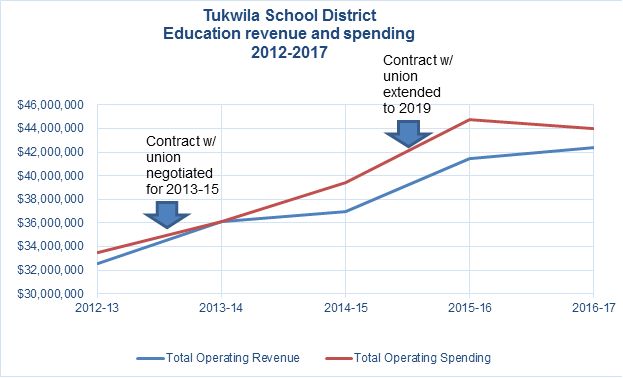As a policy analyst who studies rising education budgets, I’m often asked, “Liv, where does all that money go?”
Good question.
One insight was just provided by the community of Tukwila, located just south of Seattle. The Tukwila School District is small but is typical of districts across the state. Tukwila has five public schools and 2,914 students. Its budget is about $44 million, or roughly $15,097 per student. That is more than tuition at many private schools. Yet school officials in Tukwila, and in many other districts, say they are chronically short on funding. So where does all that money go?
The Tukwila School Board recently passed a resolution that provides part of the answer. Board members say they intend to stop the practice of secret budget negotiations with the powerful WEA union and in future make these meetings public. As the Board members explain,
“By opening the collective bargaining process to public view, the District will provide an incentive for both parties (management and labor) to take timely, reasonable, publicly defendable positions that allow the community to better understand the budget and other implications of collective bargaining contracts.”
The WEA union contract for 2013-15 matched available funding, but a new union contract, negotiated in secret, blew an enormous hole in the local school budget, skimming money that would otherwise be available to fund services for children. From 2012 to 2017, Tukwila’s education funding increased by nearly a third, or more than $10 million (see graph). But the union’s secret agreement with the District required all of that money and more. Tukwila’s budget “shortfall” is not the result of falling tax revenue – available public money has increased greatly. The problem comes from union executives using off-the-record contract talks to divert most of the funding increase to themselves.
Next time local school administrators say they are short of money and that people in the community need to pay more in taxes, ask about the WEA union contract. Chances are that will explain where much of the recent large increases in school funding are going, leaving children, once again, with the short end of the stick.
Not surprisingly, the established interests in the system tend to look out for themselves, leaving children short of the resources they need to learn.

Sources: 1) “Workload/Staffing/Finance, Tukwila School District,” Washington State K-12 Finance Data, Legislative Evaluation and Accountability Program Committee, Office of Financial Management, at https://fiscal.wa.gov/K12Districts.aspx.
2) “F-195 Budget Overview, Tukwila School District, 2011-12 through 2016-2017,” School Apportionment and Financial Services, Office of Superintendent of Public Instruction, at https://www.k12.wa.us/safs/data/reportformatter.asp.
3) “Collective Bargaining Agreement between the Tukwila School District No. 406 and the Tukwila Education Association, 2013-2019, (Bargained Extension of the 2013-2015 Collective Bargaining Agreement),” at https://tukwilaschools.org/wp-content/uploads/2016/05/2013-2019-TEA-CBA.pdf.




